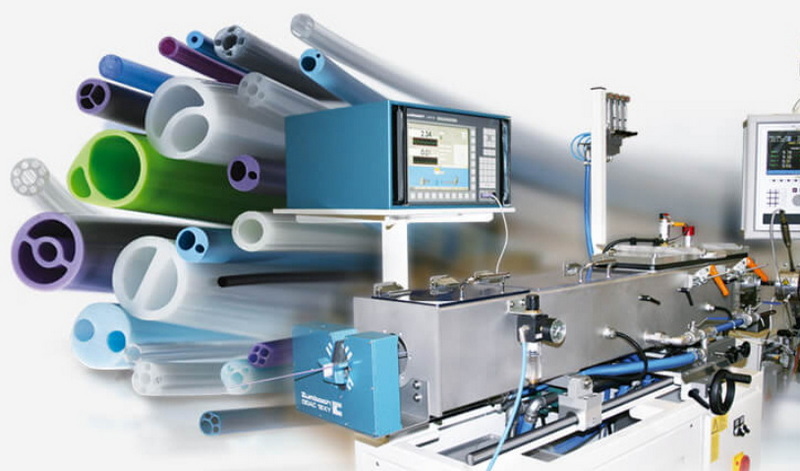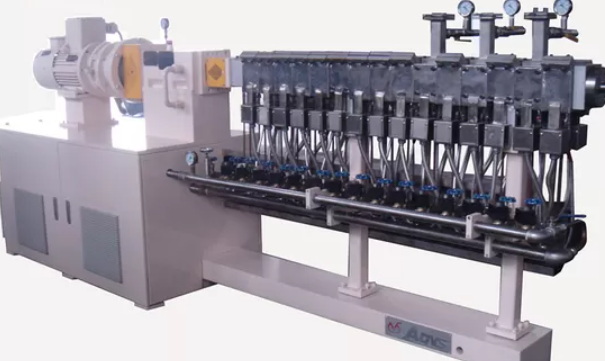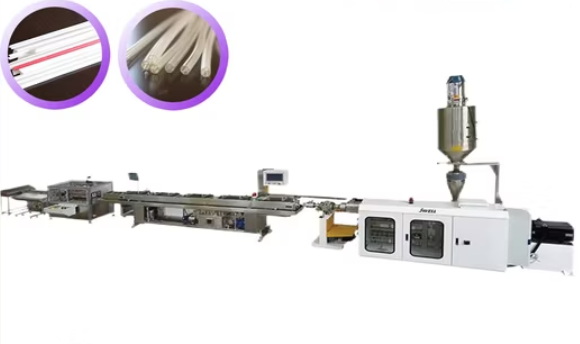Content Menu
● Introduction to Medical Tube Extrusion
>> Key Components of Medical Tube Extrusion Machinery
>> Importance of Precision in Medical Tube Extrusion
● Enhancing Quality Control with Medical Tube Extrusion Machinery
>> Raw Material Inspection
>> In-Process Monitoring
>> Dimensional Measurement
>> Functional Testing
>> Biocompatibility Assessment
>> Sterilization Validation
>> Documentation and Traceability
● Role of Medical Tube Plastic Extrusion Machinery Factories
>> Advanced Equipment
>> Operator Training
>> Quality Management Systems
● Examples of Medical Tube Extrusion Machinery
● Video: Medical Tube Extrusion Process
● Advancements in Medical Tube Extrusion Machinery
● Impact of Medical Tube Plastic Extrusion Machinery Factories on the Industry
>> Collaboration with Medical Device Manufacturers
>> Regulatory Compliance
>> Sustainability Initiatives
● Future Trends in Medical Tube Extrusion
● Conclusion
● FAQs
>> 1. What are the Key Components of Medical Tube Extrusion Machinery?
>> 2. How Does Precision Impact Medical Tube Extrusion?
>> 3. What Quality Control Measures Are Used in Medical Tube Extrusion?
>> 4. What Regulations Govern Medical Tube Extrusion?
>> 5. Why Are Medical Tube Plastic Extrusion Machinery Factories Important?
Medical tube extrusion machinery plays a crucial role in enhancing quality control in the production of medical tubes. These tubes are used in various medical applications, including catheters, IV lines, and surgical tools, where precision and biocompatibility are essential. In this article, we will explore how medical tube extrusion machinery contributes to quality control and the importance of adhering to stringent medical standards.

Introduction to Medical Tube Extrusion
Medical tube extrusion is a continuous process that transforms raw materials into precise, functional tubing. The process involves feeding medical-grade materials into an extruder, heating them to a molten state, and then pushing them through a die to achieve the desired shape. The resulting tubes must meet stringent quality standards to ensure patient safety and device reliability.
Key Components of Medical Tube Extrusion Machinery
1. Extruders: These are the heart of the extrusion line, responsible for melting and shaping the raw materials. Advanced extruders feature precision screws and barrels designed to improve material flow while reducing shear stress, leading to better quality extrusions.
2. Dies: Specialized dies determine the tubing's shape and dimensions. They are crucial for achieving the precise specifications required for medical applications.
3. Calibration Systems: These systems enhance accuracy by maintaining consistent dimensions throughout the extrusion process. Automated calibration equipment further reduces variability and improves production efficiency.
4. Cooling Tanks: Efficient cooling tanks stabilize the tubing post-extrusion, ensuring it retains its intended shape and dimensions. Advanced cooling systems use precise temperature regulation to prevent deformation and ensure uniform cooling across the tubing's surface.
5. Cutting Units: Cutting units guarantee precise tube lengths by utilizing high-speed, automated mechanisms. These systems often incorporate programmable settings to meet various length requirements, ensuring versatility and reducing waste.
Importance of Precision in Medical Tube Extrusion
Precision is paramount in medical tube extrusion to maintain tight tolerances. Temperature, pressure, and screw speed are monitored with accuracy using advanced control systems and sensors. Any deviations from these set points can result in defects such as uneven wall thicknesses, rough surfaces, or weak mechanical properties.
Enhancing Quality Control with Medical Tube Extrusion Machinery
Quality control is a multi-stage process in medical tube extrusion, involving raw material inspection, in-process monitoring, dimensional measurement, visual inspection, and functional testing. Each stage ensures that the tubing meets the required specifications and standards.
Raw Material Inspection
Inspectors verify the purity and consistency of incoming plastic pellets or granules, ensuring they are free from contaminants. Techniques like Fourier Transform Infrared Spectroscopy (FTIR) or Differential Scanning Calorimetry (DSC) can be used to analyze the chemical composition and purity of the materials.
In-Process Monitoring
The tubing is monitored and controlled during the extrusion process to ensure its diameter and properties are always uniform. Temperature, pressure, and line speed are consistently monitored and controlled. Advanced systems can adjust process parameters in real-time to maintain uniformity in quality.
Dimensional Measurement
Careful measurement of the extruded tubing at multiple points ensures accurate diameter and wall thickness. Laser micrometers and ultrasonic gauges are commonly used for this purpose.
Functional Testing
Additional functional testing is conducted on the tubing as needed to verify its performance under specific conditions. Tests may include elongation, tensile strength, and burst pressure measurements.
Biocompatibility Assessment
Biocompatibility tests are conducted according to ISO 10993 standards to ensure the tubing is safe for use in medical applications. This includes cytotoxicity, sensitization, and irritation tests.
Sterilization Validation
Sterilization methods such as ethylene oxide (EtO) and gamma irradiation are validated to ensure they effectively kill bacteria without compromising the integrity of the tubing.
Documentation and Traceability
Detailed records are kept for each batch produced, including test results, deviations, and corrective measures. This ensures traceability and compliance with regulatory requirements.

Role of Medical Tube Plastic Extrusion Machinery Factories
Medical tube plastic extrusion machinery factories play a vital role in ensuring that the extrusion process meets stringent quality standards. These factories invest in advanced equipment and rigorous quality control measures to produce high-quality medical tubes.
Advanced Equipment
Factories utilize high-precision extrusion equipment featuring advanced control systems to consistently produce medical tubing that meets precise specifications. Regular calibration and maintenance of this equipment are essential to ensure accuracy and reliability.
Operator Training
Employees involved in the extrusion process undergo comprehensive training in quality control procedures and adherence to relevant standards. This ensures that all personnel understand the importance of maintaining high-quality production.
Quality Management Systems
Implementing standardized quality management systems (QMS) helps factories record procedures, oversee quality assurance, and continuously improve their processes. This commitment to quality is crucial for maintaining compliance with international standards like ISO 13485 and FDA regulations.
Examples of Medical Tube Extrusion Machinery
1. HMG Extrusions Medical Tube Extrusion Line: This line includes a single screw extruder, co-extruder for color stripes, cooling tank, haul-off system, and online diameter gauge meter. It is capable of producing medical tubes with precise dimensions and quality.
2. Conair Medline Extrusion System: This system features a high-performance extruder and advanced control systems for precise tube sizing and tapering. It includes a vacuum-sizing/cooling tank and ultrasonic gauges for real-time dimension monitoring.
Video: Medical Tube Extrusion Process
To better understand the extrusion process, you can view a demonstration of a medical tube extrusion line in action:
Advancements in Medical Tube Extrusion Machinery
Recent advancements in medical tube extrusion machinery have significantly improved quality control. These include:
- Multi-Layer Extrusion: This technology allows for the creation of complex tubing structures with multiple layers, each serving a specific function such as insulation, reinforcement, or biocompatibility enhancement.
- Nano-Structured Materials: Incorporating nano-structured materials into the extrusion process can enhance the mechanical properties and biocompatibility of the tubing.
- Automated Quality Control Systems: Advanced sensors and AI-driven monitoring systems can detect defects in real-time, allowing for immediate adjustments to the extrusion process.
- 3D Printing Integration: Some factories are integrating 3D printing techniques to create custom connectors or fittings for medical tubes, offering greater flexibility in design and functionality.
Impact of Medical Tube Plastic Extrusion Machinery Factories on the Industry
The role of medical tube plastic extrusion machinery factories extends beyond production to influencing industry standards and innovation. By investing in research and development, these factories drive advancements in extrusion technology, contributing to improved patient outcomes and device reliability.
Collaboration with Medical Device Manufacturers
Factories often collaborate with medical device manufacturers to develop custom tubing solutions that meet specific application needs. This collaboration ensures that the tubing is optimized for its intended use, enhancing overall device performance.
Regulatory Compliance
These factories must comply with stringent regulations such as ISO 13485 and FDA guidelines. Compliance ensures that all produced tubing meets international safety and quality standards.
Sustainability Initiatives
Many factories are adopting sustainable practices, such as using eco-friendly materials and reducing waste through efficient production processes. This not only benefits the environment but also aligns with the growing demand for sustainable medical products.
Future Trends in Medical Tube Extrusion
As technology continues to evolve, we can expect several trends to shape the future of medical tube extrusion:
- Increased Use of Bioplastics: Bioplastics offer a sustainable alternative to traditional plastics, potentially reducing environmental impact while maintaining biocompatibility.
- Advanced Materials: The integration of advanced materials with enhanced properties, such as antimicrobial coatings or self-healing materials, could further improve device performance and patient safety.
- Digitalization and Automation: Further automation and digitalization of the extrusion process will enhance precision, reduce variability, and improve real-time monitoring capabilities.
Conclusion
Medical tube extrusion machinery enhances quality control by providing precise and consistent production of medical tubes. The machinery ensures that tubes meet stringent medical standards, including biocompatibility, durability, and performance under different conditions. By investing in advanced equipment and rigorous quality control measures, medical tube plastic extrusion machinery factories play a crucial role in maintaining patient safety and device reliability.

FAQs
1. What are the Key Components of Medical Tube Extrusion Machinery?
The key components include extruders, dies, calibration systems, cooling tanks, and cutting units. Each component is crucial for achieving precise specifications and maintaining quality control.
2. How Does Precision Impact Medical Tube Extrusion?
Precision is vital for maintaining tight tolerances in medical tube extrusion. It ensures uniformity in dimensions such as wall thickness and diameter, reducing the risk of defects like uneven surfaces or weak mechanical properties.
3. What Quality Control Measures Are Used in Medical Tube Extrusion?
Quality control measures include raw material inspection, in-process monitoring, dimensional measurement, visual inspection, functional testing, biocompatibility assessment, and sterilization validation. These steps ensure that the tubing meets all required specifications and standards.
4. What Regulations Govern Medical Tube Extrusion?
Medical tube extrusion is governed by regulations such as ISO 13485, ISO 10993, USP Class VI, FDA 21 CFR Part 820, and EU MDR. These standards ensure the safety and reliability of medical devices.
5. Why Are Medical Tube Plastic Extrusion Machinery Factories Important?
These factories are important because they invest in advanced equipment and rigorous quality control measures to produce high-quality medical tubes. They ensure compliance with international standards, maintaining patient safety and device reliability.






















